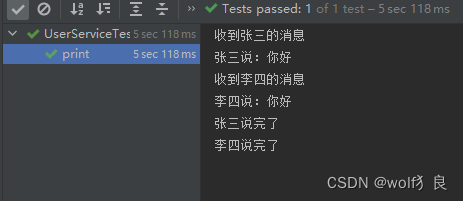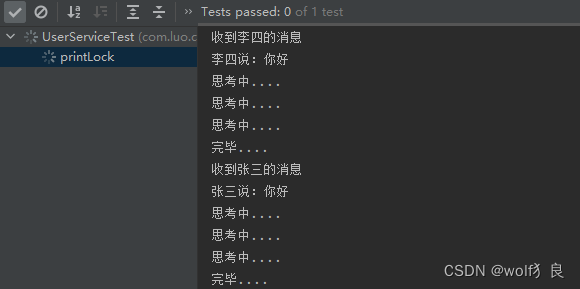- 本章:将展示SpringBoot集成Redis三种客户端的配置要点和常见应用示例;
- 下章:自行实现一个方法级的缓存注解,简化版的Cacheable,使初学者加深对Spring缓存框架的理解。
一、Lettuce客户端
Lettuce 是一种可扩展的、线程安全的 Redis 高级客户端。
从 Spring Boot 2.x 开始, Lettuce 已取代 Jedis 成为SpringBoot 默认的 Redis 客户端。
- 相比于 Jedis,Lettuce更加全面,并且解决了 Jedis 客户端实例存在非线程安全的问题
- 支持同步编程,异步编程,响应式编程,自动重新连接,主从模式,集群模块,哨兵模式,管道和编码器等等高级的 Redis 特性
- Lettuce 底层基于 Netty 框架的事件驱动与 redis 通信,采用了非阻塞的 I/O 操作,可异步调用,相比 Jedis,性能高
- Lettuce 的 API 是线程安全的,如果不是执行阻塞和事务操作,如 BLPOP 和MULTI/EXEC 等命令,多个线程就可以共享一个连接,性能方面不会衰减。
1.1 pom.xml引入依赖
<parent><groupId>org.springframework.boot</groupId><artifactId>spring-boot-starter-parent</artifactId><version>2.1.3.RELEASE</version><relativePath/> </parent><dependencies><!-- redis 缓存操作 默认使用 Lettuce 客户端--><dependency><groupId>org.springframework.boot</groupId><artifactId>spring-boot-starter-data-redis</artifactId></dependency><!-- pool 对象池 Lettuce客户端依赖的插件--><dependency><groupId>org.apache.commons</groupId><artifactId>commons-pool2</artifactId></dependency><!-- 阿里JSON解析器 --><dependency><groupId>com.alibaba.fastjson2</groupId><artifactId>fastjson2</artifactId><version>2.0.34</version></dependency><!-- 方便等会写单元测试 --><dependency><groupId>org.springframework.boot</groupId><artifactId>spring-boot-starter-test</artifactId><scope>test</scope></dependency><!-- 单元测试 --><dependency><groupId>junit</groupId><artifactId>junit</artifactId><version>4.12</version><scope>test</scope></dependency></dependencies>1.2 application.yml
配置redis服务器配置
spring:redis:# 地址host: localhost# 端口,默认为6379port: 6379# 数据库索引database: 0# 密码password: 123456# 连接超时时间timeout: 10slettuce:pool:# 连接池中的最小空闲连接min-idle: 0# 连接池中的最大空闲连接max-idle: 8# 连接池的最大数据库连接数max-active: 8# #连接池最大阻塞等待时间(使用负值表示没有限制)max-wait: -1ms1.3 redis缓存应用
UserService.java
@Service
public class UserService {//由于引入redis-starter包,spring已经完成了RedisTemplate 对象创建,什么都不用做就可以直接使用了。@AutowiredRedisTemplate redisTemplate;/*** 最简单的使用,通过key-value方式存取变量;* @param username* @return*/public Object getUserInfo(String username) {//通过用户名从缓存获取用户信息,如果没有即新建并存缓存起来;if (redisTemplate.opsForValue().get(username) == null) {System.out.println("未获取到缓存,新建用户信息.............");Map<String, Object> user = new HashMap<>();user.put("username", username);user.put("usercode", "zhangsan");user.put("sex", "男");user.put("createtime", new Date());redisTemplate.opsForValue().set(username, user);}return redisTemplate.opsForValue().get(username);}//从缓存获取,如果没有则新建,并设置了过期时间为10秒。public Object getUserInfo2(String username) {if (redisTemplate.opsForValue().get(username) == null) {System.out.println("未获取到缓存,新建用户信息.............");Map<String, Object> user = new HashMap<>();user.put("username", username);user.put("usercode", "zhangsan");user.put("sex", "男");user.put("createtime", DateUtils.format(new Date()));redisTemplate.opsForValue().set(username, user);//10秒后过期redisTemplate.expire(username, 10, TimeUnit.SECONDS);}return redisTemplate.opsForValue().get(username);}
}
1.3测试
UserServiceTest.java
@Testpublic void testRedis() {Object user = userService.getUserInfo("2");System.out.println(user);}输出:

给缓存设置过期时间,再来存取。
@Testpublic void testRedisExpire() throws InterruptedException {System.out.println(userService.getUserInfo2("11"));Thread.sleep(1000);System.out.println(userService.getUserInfo2("11"));Thread.sleep(1000);System.out.println(userService.getUserInfo2("11"));Thread.sleep(9000);System.out.println(userService.getUserInfo2("11"));}
输出:
缓存过期时间设置为10秒,当第4次取值时,发现已经过期,自然需要新建对象了。

二、Redis客户端
Jedis 是一款老牌 Redis 的 Java 客户端,提供了比较全面的 Redis 命令的操作支持,也是目前使用最广泛的客户端。
优点如下:
- Jedis 的 API 提供了比较全面的 Redis 命令的支持
- Jedis 中的 Java 方法基本和 Redis 的 API 保持着一致,也就是说了解 Redis 的API,可以熟练的使用 Jedis
- 支持 pipelining、事务、LUA Scripting、Redis Sentinel、Redis Cluster等等 redis 提供的高级特性
- 客户端轻量,简洁,便于集成和改造
缺点如下:
- 使用阻塞的 I/O 操作,且其方法调用都是同步的,程序流需要等到 sockets 处理完 I/O 才能执行,不支持异步
- Jedis 在实现上是直接连接的 redis server,如果在多线程环境下是非线程安全的,这个时候可以使用连接池来管理 Jedis,已解决 Jedis 客户端实例存在非线程安全的问题
- 不支持读写分离,需要自己实现
2.1 pom.xml依赖引入
在实际SpringBoot项目中绝大多数情况都不会要求说使用Redis客户端,只有遇到变态需求时可能才会用到吧。不论是用Lettuce 还是用Redis,SpringBoot提供给我们使用的RedisTemplate 接口都是一致的。和Lettuce的差异只是引入的包的差异,SpringBoot已经默认帮我们引入Letucce了,如果要用Redis,那还得排除Letucce的引入,而指定引入Redis。如下:
<!-- 实现对 Spring Data Redis 的自动化配置 --><dependency><groupId>org.springframework.boot</groupId><artifactId>spring-boot-starter-data-redis</artifactId><exclusions><!-- 去掉对 Lettuce 的依赖,因为 Spring Boot 优先使用 Lettuce 作为 Redis 客户端 --><exclusion><groupId>io.lettuce</groupId><artifactId>lettuce-core</artifactId></exclusion></exclusions></dependency><!-- 引入 Jedis 的依赖,这样 Spring Boot 实现对 Jedis 的自动化配置 --><dependency><groupId>redis.clients</groupId><artifactId>jedis</artifactId></dependency>代码中使用方法与Lettuce是完成一致的。
三、Redisson
Redisson 是一个在 Redis 的功能基础上实现的 Java 驻内存数据网格客户端。实现了分布式和可扩展的 Java 数据结构,提供很多分布式相关操作服务,例如分布式锁,分布式集合,可通过 Redis 支持延迟队列。
Redisson和前两兄弟的区别就像一个用鼠标操作图形化界面,一个用命令行操作文件。Redisson是更高层的抽象,Jedis和Lettuce是Redis命令的封装。
Reddisson 的出现不是又来干一次Redis和Lettuce干过的事儿,而是站在巨人肩膀上干更大的事儿:让猿猿们在分布式场景下也能少掉些头发。
优点如下:
- 实现了分布式特性和可扩展的 Java 数据结构,例如分布式锁,分布式集合,分布式对象,分布式远程调度等等高级功能,适合分布式开发
- 与 Lettuce 一样,基于 Netty 框架的事件驱动与 redis 通信,支持异步调用,性能高
- Redisson 的 API 是线程安全的,所以可以使用单个 Redisson 连接来完成各种操作。
- 支持读写分离,支持读负载均衡,在主从复制和 Redis Cluster 架构下都可以使用
- 内建 Tomcat Session Manager,为 Tomcat 6/7/8 提供了会话共享功能,可以与 Spring Session 集成,实现基于 Redis 的会话共享
- 相比于 Jedis、Lettuce 等基于 redis 命令封装的客户端,Redisson 提供的功能更加高端和抽象,Redisson 可以类比 Spring 框架,这些框架搭建了应用程序的基础框架和功能,可以显著提升开发效率,让开发者有更多的时间来关注业务逻辑
所以从应用上讲,Redis和Lettuce能做的是Redisson都能做,其次还能干分布式下的粗活累活。
3.1 依赖引入
Redisson本身是基于Redis做的延伸,所以引入Redisson的时候就已经引入Redis包了,所以只需引入Redisson依赖就可以使用Redis的相关功能了。只是使用上与前面会有差异,效果都一样。
<dependency><groupId>org.springframework.boot</groupId><artifactId>spring-boot-starter </artifactId></dependency><!--使用redisson作为缓存--><dependency><groupId>org.redisson</groupId><artifactId>redisson</artifactId><version>3.17.3</version></dependency>3.2Redisson对象配置
由于没有引入SpringBoot对Redisson的自动配置,这里进行手动配置一下,创建RedissonConfiguration.java
package com.luo.chengrui.labs.lab03.config;import org.redisson.Redisson;
import org.redisson.config.Config;
import org.springframework.beans.factory.annotation.Value;
import org.springframework.boot.autoconfigure.condition.ConditionalOnProperty;
import org.springframework.cache.annotation.CachingConfigurerSupport;
import org.springframework.context.annotation.Bean;
import org.springframework.context.annotation.Configuration;/*** redis配置*/
@Configuration
public class RedissonConfig extends CachingConfigurerSupport {//创建redisson对象,这是单机版,另外还支持哨兵,和集群。@Bean(name = "redisson")@ConditionalOnProperty(prefix = "spring.redis", name = "host")public Redisson redissonSingleServer(@Value("${spring.redis.host}") String host, @Value("${spring.redis.port}") String port, @Value("${spring.redis.password}") String password) {Config config = new Config();config.useSingleServer().setAddress("redis://" + host + ":" + port);config.useSingleServer().setPassword(password);return (Redisson) Redisson.create(config);}}3.3 redis服务器配置
与前面的配置一毛一样。。。。
3.4 Redisson的应用:(一)作为缓存
@Service
public class UserService {@AutowiredRedisson redisson;@Resourceprivate RedissonClient redissonClient;private static final String USER_CACHE = "USER_CACHE";//与Redis、Lettuce相似的功能,这里使用MapCache,还提供了如对列、链表等对象public Object getUser(String username) {if (redissonClient.getMapCache(USER_CACHE).get(username) == null) {System.out.println("未获取到缓存,新建用户信息.............");Map<String, Object> user = new HashMap<>();user.put("username", username);user.put("usercode", "zhangsan");user.put("sex", "男");user.put("createtime", new Date());redissonClient.getMapCache(USER_CACHE).put(username, user);}return redissonClient.getMapCache(USER_CACHE).get(username);}}
代码验证:
@Testpublic void mapCache() {System.out.println(userService.getUser("11"));System.out.println(userService.getUser("2"));}
输出:

Redis服务器端存储数据展示,这里由于没有配置序列化,所以键和值都编码过了,不太识别。

3.5 Redisson应用:(二)分布式锁
测试代码为两个方法:处理用户消息打印。一个加了分布式锁,一个没有加锁的方法,测试时使用多线程模拟分布式效果。
- 加了分布式锁,即希望所有服务端同一时间仅一人能说话,其他人必须 等待说了“完毕”后,才能说话;
- 不加分布式锁,不加分布式锁,但同一时间仅一人能说话,实际也应该加锁。但对于分布式来说,单机加不加锁都不影响。为了测试就不加锁。
不用分布式锁:
public void print(String user, String content) {try {System.out.println(String.format("收到%s的消息", user));System.out.println(String.format("%s说:%s", user, content));Thread.sleep(3000);System.out.println(String.format("%s说完了", user));} catch (Exception ex) {throw new RuntimeException(ex);} finally {}}@Testpublic void print() {new Thread(() -> {userService.print("张三", "你好");}).start();new Thread(() -> {userService.print("李四", "你好");}).start();try {Thread.sleep(5000);} catch (InterruptedException e) {e.printStackTrace();}}
输出:
都没有等张三说“完毕”时,李四已经开始说话了。如果是在做秒杀、抢购。那只能快点提桶跑路!

加了分布式锁的情况:
public void printLock(String user, String content) {RLock lock = null;try {lock = redisson.getLock("printNow");lock.lock();System.out.println(String.format("收到%s的消息", user));System.out.println(String.format("%s说:%s", user, content));for (int i = 0; i < 3; i++) {System.out.println("思考中....");Thread.sleep(1000);}System.out.println("完毕....");} catch (Exception ex) {throw new RuntimeException(ex);} finally {if (lock != null) {lock.unlock();}}}@Testpublic void printLock() {new Thread(() -> {userService.printLock("张三", "你好");}).start();new Thread(() -> {userService.printLock("李四", "你好");}).start();try {Thread.sleep(50000);} catch (InterruptedException e) {e.printStackTrace();}}
输出:加了分布式锁之后,只要没有说完毕,张三就必须一直等待。

综上,本章内容完毕了。
总结
- Lettuce是SpringBoot自带的Redis客户端,性能比Redis要好, 是线程安全的,支持同步编程,异步编程,响应式编程,自动重新连接,主从模式,集群模块,哨兵模式
- Redisson 是一个在 Redis 的功能基础上实现的 Java 驻内存数据网格客户端。实现了分布式和可扩展的 Java 数据结构,提供很多分布式相关操作服务,例如分布式锁,分布式集合,可通过 Redis 支持延迟队列。
1、Lettuce的自动配置
<!-- redis 缓存操作自动配置 使用 Lettuce 客户端--><dependency><groupId>org.springframework.boot</groupId><artifactId>spring-boot-starter-data-redis</artifactId></dependency><!-- pool 对象池 Lettuce 要依赖这个--><dependency><groupId>org.apache.commons</groupId><artifactId>commons-pool2</artifactId></dependency>
代码中使用自动注入即可
@Service
public class UserService {@AutowiredRedisTemplate redisTemplate;//redisTemplate.opsForValue().get("zhangsan")//redisTemplate.opsForValue().set("zhangsan", "李四");
}
2、Redisson的自动配置
引入redisson的自动配置后,我们上面示例中的RedissonConfiguration类也不需要写了,直接用就行。
<dependency><groupId>org.redisson</groupId><artifactId>redisson-spring-boot-starter</artifactId><version>3.17.3</version></dependency>
代码中直接注入即可:
@Service
public class UserService {@AutowiredRedisson redisson;@Resourceprivate RedissonClient redissonClient;
}






)












